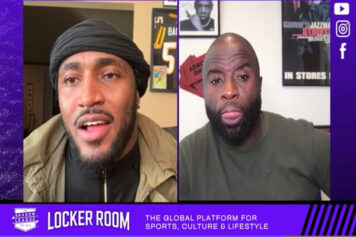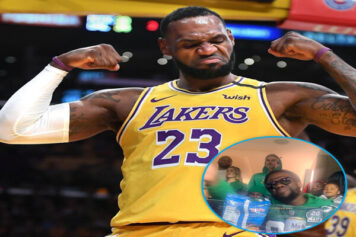In the early spring of 2013, I found myself at the National High School Invitational on the campus of Georgetown Prep in Bethesda, Maryland. The tournament, which has since been renamed the Dick’s Sporting Goods High School Nationals and moved to New York’s Madison Square Garden, assembles some of the top squads in the country for a March Madness-style, lose-and-go-home event to determine the supposed prep national champion.
The talent in the gym over the tourney’s three days is enough to make Dick Vitale spontaneously combust.
I couldn’t wait to see Florida’s Montverde Academy squad in action back then because they featured one of the dopest high school backcourts in the country, with senior point guard Kasey Hill and junior combo-guard extraordinaire D’Angelo Russell.
In addition, I wanted to break down the skill set of their massive 6-foot-10 center from Brooklyn who was heading to play at the University of Kentucky that next season, Dakari Johnson.
A few minutes into their first game, a 6-foot-8 lefty came in off the bench. I looked at my roster to put a name to the number on his jersey, and it wasn’t printed in the program.
As soon as he touched the ball, my eyes widened. He received a pass down on the block, turned around to face the basket, and when he put the ball on the floor, I was already in love. He converted a sweet move that was complex in nature, kissing the ball off the glass with a gentle touch over some very big and strong competition. And he made it look easy.
Seated next to me was a Nike rep who I’d seen at numerous elite high school events over the years. I nudged him with my elbow and said, “My goodness! Who is that kid?”
“That’s Ben Simmons,” he told me. “He’s from Australia. Only a sophomore. This is the first game he’s played in America. We’ve been waiting for him to get here for years!” The look of adoration on his face said it all, as did the excitement powering those words.
By halftime, I was already convinced that I was looking at the future of the game. He was a tough and passionate competitor, played every position on offense and defense, handled and passed the rock like Magic in the open the floor, and had the combination of size, skills and gifts that you don’t even see in the NBA.
At halftime, I ran out of the gym to call my friend and mentor, Garry D. Howard, who was then the Editor-in-Chief at Sporting News.
“Ayo G! I just saw the next coming of LeBron James. Seriously, this kid is the future. Write it down. 6-foot-8 lefty from Australia. His name is Ben Simmons. I gotta run, they’re about to tip off the second half.”
And from that moment on, I was thankful that I’d been let in on the secret of B-ball’s next big thing before the rest of the world later found out.
In Showtime’s new documentary, One and Done, Simmons’ world is laid bare for all to see, from growing up in Australia, his family dynamic, the move to play in America at Montverde, and ultimately, his lone season of college basketball at LSU.
It’s a glimpse into the world of a child prodigy and the elite basketball apparatus that kids walk through en route to the NBA.
Simmons needs to be commended for his honesty in the film. He pulls no punches about the fact that he’s only biding his time at LSU for one semester until he can enter the NBA Draft. He’s under no illusion that he’s a student-athlete, and is adamant that he’s only there to play basketball in a system that says, no matter how gifted, a kid has to wait a full year after his high school graduation until he can be employed by the NBA.
It seems absurd to watch him with $40 left in his pocket, which he says needs to last him for a couple of weeks after a trip to the local Walmart, and juxtapose that with the NCAA system that rakes in billions off of his talent, and the skills of so many others of similar stature.
“Thats my job if Im [in the NBA]. So dont say Im an amateur and make me take pictures and sign stuff,” Simmons said in frustration while talking to his family. “Go buy a No. 25 jersey. Youre going to put me on ESPN. Youre going to make hundreds of millions of dollars off one person. So Im going off on the NCAA.”
He says that he often feels like he’s wasting his time. And that’s to be expected from someone with his teenage perspective. But he fails to recognize that the rule he’s adamantly opposed to is not an NCAA one, but rather one implemented by the NBA.
And it’s not as if he didn’t have choices. He could have turned pro and played overseas, or in the D League for a year to enhance his skills. But he chose to play college ball, and the advantages of doing so, within the confines of this limited system, benefited him immensely.
The NCAA’s marketing machine and the amount of time his skills were talked about on widely watched cable sports shows after games like the one where he had 43 points, 14 rebounds, 7 assists, 5 steals and 3 blocks in a 119108 win over North Florida, all worked in his favor.
The national television exposure he received throughout the season, especially in marquee matchups against other top teams, all of it laid the foundation for his name and image recognition that opened the door to the numerous blockbuster endorsement deals he later signed prior to being drafted with the overall #1 pick by the Philadelphia 76’ers.
The doc flows in real time, and it’s refreshing to hear him talk about why he’s ditching his classes in favor of working out in the gym. In front of the regular TV cameras during the season, he says all the right things. But in front of the cameras following him for the documentary, in his private moments, that’s when we get a sense for how he really feels.
When confronted about missing one class in particular, he says, “It really was a joke. It was a class about preparing for better study habits or skills. Im going to the NBA next season. So why bullshit if its not going to help me?”
But whether you agree with the NBA age minimum or not, it’s here to stay. The league wants its players polished and with a bigger national profile once they hit the stage to shake hands with commissioner Adam Silver. And as a matter of fact, the NBA would really like to extend the age minimum, which is currently at 19 years old, for another full year so that there are no teenagers on rosters.
The film makes Simmons the modern-day face of the absurdity of the one-and-done college system as he unleashes his scorn on college players generating huge revenue streams, and others profiting off of an unpaid labor pool while perpetuating the myth, at least for the most gifted athletes who are in and out the universities’ doors quicker than the first season of Atlanta, of the so called “student-athlete.”
There’s a lot to unpack on that side of the film, but its better moments revolve around his relationship with his family, his struggles (despite being the only player in the country to lead his team in every major statistical category with 19 points, 12 rebounds, five assists, two steals and one block per game) in getting LSU to the NCAA Tournament, and the whirlwind courtship by the player agents and sneaker companies that are salivating to sign him as a client.
One and Done airs tonight, Friday, November 4th, on Showtime at 9:00PM EST.
If you’re a sports fan, or are interested in a peek into the life of a child prodigy on his own unique NBA journey, it’s worth your time.
I enjoyed walking along with Simmons in pursuit of his NBA dream, and hearkening back to the first time I saw him when he was a high school sophomore. And as the final credits rolled on One and Done, he had me singing along with my former Brooklyn neighbor-with-the-flavor when he said, “I’m blowing up like you thought I would!”
But for Ben Simmons, he ain’t staying in the same crib in the same hood any more. The young fella is about to be the next LeBron James.
And that’s all good!



